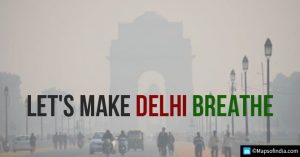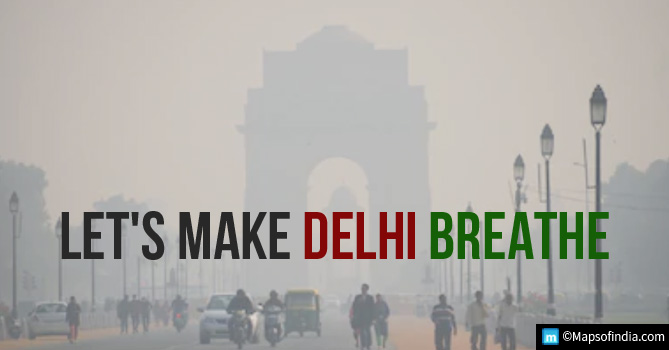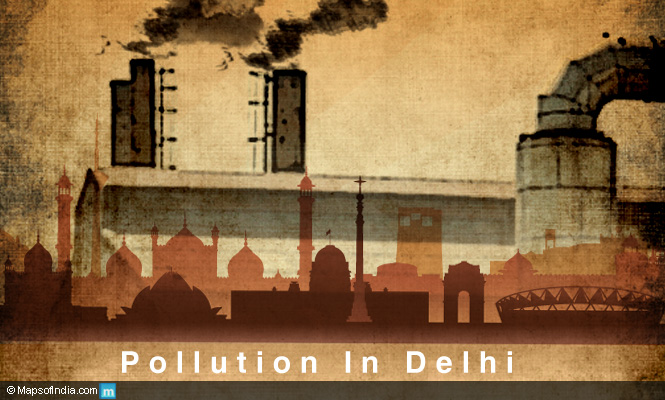
As Delhi is all geared up for winters, the air pollution index once again strikes the startling levels leaving the government and its citizens anxious and puzzled. Air pollution in Delhi has become a rising public concern, making the state one of the most researched city with much superfluous media attention. Despite possible measures being taken by the government and the Delhiites to curb air pollution, it seems uncontrollable.
Over the last many years, Delhi’s air quality witnessed a fall in the months of October-November due to slow winds and dropping temperatures. Pollutants like dust particles, stubble burning, and smoke emitted by vehicles and industries are majorly responsible for turning the national capital practically into a gas chamber. In May 2018, the World Health Organisation (WHO) declared Delhi as the most polluted city on the basis of the air quality data that it collected for the world’s megacities with a population above 14 million.
In November 2017, the city’s air got immensely polluted spiking the pollution levels beyond tolerable levels. Delhi even left behind Beijing, the world’s most polluted city, after a number of air pollutants in its air rocketed by ten times in the same year. As a countermeasure to fight air pollution in Delhi, last year, the Supreme Court reduced the number of cracker sale licenses to be issued to half all over Delhi and National Capital Region as the entire city was engulfed under a blanket of poisonous haze for days.
This year, the government has formulated an emergency action plan “Graded Response Action Plan (GRAP)” in the national capital from 15th October 2018 to fight ‘very poor’ and ‘severe’ air pollution levels. The first plan of action was putting a ban on the diesel generators, at a time when Delhi has already been dealing with ‘poor’ air quality for nine days in the first two weeks of October.
Air Quality Index: An authentic report card on Delhi’s air pollution levels
The Air Quality Index has now become an acquainted term for every Delhiite. This index not only gives a fair picture of the pollution levels of any city but also provides the health implications of this rise.
| Air Quality Index | Level of Impact on Health | Remarks |
| 0-50 | Minimal damage | Good |
| 51-100 | Little discomfort in breathing to sensitive people | Satisfactory |
| 101-200 | Discomfort in breathing is experienced by people with asthma and heart diseases | Moderate |
| 201-300 | Discomfort in breathing is experienced by people exposed to pollution for a longer time | Poor |
| 301-400 | Very unhealthy for people; leading to respiratory illnesses on prolonged exposures | Very Poor |
| 401-500 | Extremely hazardous to human health; it severely affects not only healthy people but also the ones suffering from respiratory diseases | Severe |
What causes air pollution in Delhi?
A confluence of an ample number of factors that can be held responsible for this dreary situation. The lack of responsibility among the officials and ignorance among the city people have led to such legendary proportions of air pollution today. Pollutants like dust particles, stubble burning, burning of firecrackers on Diwali, and smoke emitted by vehicles and industries are majorly responsible for worsening the air quality of Delhi every other day.
Stubble burning: An yearly affair?
It is that time of the year now when the people of Delhi have held their breath as the deathly smog of stubble burning is about to encapsulate the national capital, turning it into a gas chamber. Pollution in Delhi and the neighboring areas shoot up due to stubble burning by farmers of Punjab and Haryana and Buring of firecrackers during Diwali.
Stubble burning in the neighboring states of Punjab and Haryana have been deteriorating the air quality of Delhi every winter. As per the latest satellite images released by NASA, there has been an increase in the cases of stubble burning all over Punjab and Haryana over the last 15 days. The farmers of both states have been engaged in preparing their fields for the next crop.
There is a ban imposed on stubble burning in fields. As there is no other alternative left for the farmers of both these states, so they have to continue with the conventional and unscientific practice of stubble burning. Despite knowing the hazards the stubble burning is causing, the governments of Punjab and Haryana have failed to introduce any other detailed action plan to deal with the challenge.
If this situation continues to exist, the smog generated due to stubble burning will flow into Delhi, worsening the air quality even more.
Graded Response Action Plan (GRAP)
To tackle the current situation of air pollution in Delhi, the Central Pollution Control Board (CPCB) has adopted an emergency plan called Graded Response Action Plan (GRAP) to take strict action to improve the air quality of the city. This plan was rolled out all over Delhi on 15th October 2018 to fight against ‘very poor’ and ‘severe’ air pollution levels in the national capital. The first initiatives launched under this plan is the banning of the diesel-powered generators sets and the construction activities in Delhi.
The CPCB has deployed 41 teams all over Delhi and NCR region to keep a check on the proper implementation of the norms to prevent air pollution. A team of 83 environment marshals has also been deployed by the Delhi Pollution Control Committee (DPCC) to monitor the violations such as open garbage burning and open construction sites. Stringent orders have also been given to the traffic police to check that no violation takes place. The local police officers have been instructed to issue challans if they encounter any activity of burning of leaves or other items. The routes of some trucks have also been diverted through the Eastern Peripheral Expressway.
The CPCB has so far conducted 96 inspections through its teams all over Delhi NCR and these inspections would intensify more in the coming days.
Measures to be taken under this plan
- If the air quality lies in moderate to poor category: Putting a stop on burning of garbage in landfills and other places and implementing pollution control regulations in industries and brick kilns.
- If the air quality falls in the very poor category: Stopping the use of diesel generator sets, increasing parking fees by four times, and increased frequency of buses and metros.
- If the air quality falls in the severe category: Increased frequency of mechanized cleaning of roads, odd-even scheme, recognizing road stretches with high dust production and the sprinkling of water on roads.
- If the air quality falls to severe plus emergency category: Restricting the entry of trucks into Delhi (except essential commodities), halting of construction activities, and shutting of schools, if necessary.
Role of South Delhi Municipal Corporation (SDMC) in tackling pollution in Delhi
The South Delhi Municipal Corporation (SDMC) has asked the state-run NBCC to “immediately halt” all its construction and demolition activities at its project site at Pragati Maidan in Delhi. On October 14, it hired 22 additional water tankers for the sprinkling of water in the open areas, including Batla House to Okhla Head Works, Okhla SLF, Jal Vihar, Lajpat Nagar, Defence Colony, Sunder Nagar, R K Puram sectors 1 and 4 and Bhairon Marg.
Role of Environment Pollution (Prevention and Control) Authority (EPCA) in tackling pollution in Delhi
The Supreme Court-empowered Environment Pollution (Prevention and Control) Authority has been given the task of implementing various measures to curb air pollution in the Delhi-National Capital Region. This authority is responsible for conserving and improving the quality of the environment; controlling the environmental pollution in the National Capital Region. The EPCA is the one which administered the Graded Response Action Plan (GRAP) in the city considering the city’s pollution levels.
Read more…
- Air Pollution in Delhi Is Alarming – Vehicles the Culprit
- Delhi to Get 20 New Air Pollution Monitoring Stations
- Air Pollution in Delhi: Graded Response Action Plan Ahead of Diwali
- 10 Ways to Protect Children From Air Pollution
- Choking Over Pollution: Delhi’s Toxic Air Truth
- Air pollution in India
- Pollution in Delhi: Industrial Units Choking Residential Areas





